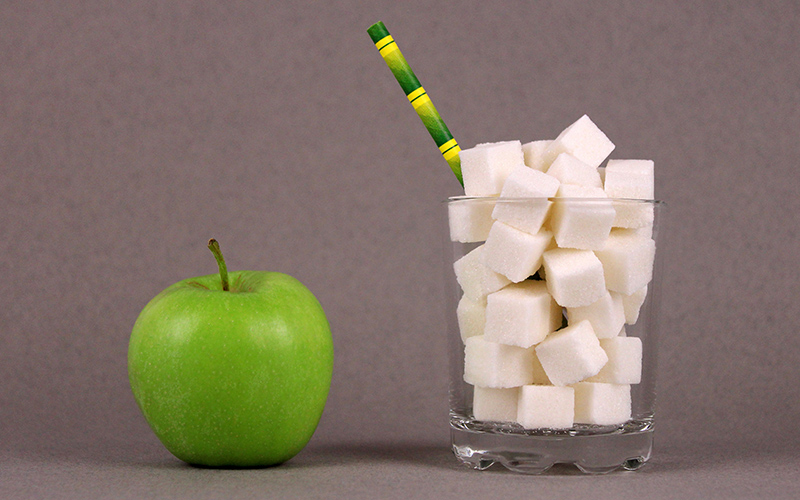
Nearly every American eats far more added sugar than recommended—and the health consequences could be dire. Here’s how to cut back without sacrificing taste.
A fresh strawberry, straight from the patch. The dense, nutty flavor of a winter squash. These natural sources of sugar not only taste good, they provide important nutrients like fiber and disease-fighting antioxidants.
But manufacturers add other sugars to foods and drinks during processing. The main sources of added sugars include sweetened drinks, desserts, sweet snacks and candy. But they are also used to “improve the flavor” of nutritious foods like low-fat dairy, whole-grain cereals and vegetables, think fruit-flavored yogurt, chocolate milk, granola and marinara sauces.
Small amounts aren’t a big deal. However, it’s all too easy for added sugars to, well, add up. Added sugars lack nutrients, and research has linked them to health hazards. Here’s why experts recommend cutting back—and how you can do so without making your diet bland or boring.
Sugary Stats
The latest government guidelines suggest limiting added sugars to no more than 10% of your daily calories. For the average adult, that’s 12 teaspoons, or 48 grams. Kids should stick with even less, just 7 or 8 teaspoons at most, or 30 to 35 grams.
Recent data suggests most people are overdoing it. On average, kids and grown-ups alike devour about 17 teaspoons of added sugars per day. That’s 272 calories, more than 13% of daily calories for adults, and 17% for children.
What’s more, some experts feel the 2020 guidelines may not go far enough. The Dietary Guidelines Advisory Committee, a federal committee of academics and doctors, suggested adults should limit their intake of added sugars to no more than 6% of their daily calories.
Tallying the Risks
Added sugars offer zero nutrition. The calories you consume would be better spent on foods rich in the nutrients you need to thrive. In fact, one study found the more added sugars you eat, the more likely you’ll fall short on vitamins C, D, and E, and the mineral magnesium.
In addition, high intake of added sugars has been linked to:
- Cavities
- Adult acne
- High blood pressure
- Abnormal cholesterol levels, even in children
- Type 2 diabetes, at any age
- Extra fat around the heart and other organs—a big problem for heart health
- Heart disease, and deaths from it
- Some cancers, including colorectal cancer
Experts are still working to understand exactly why. Some types of added sugars may prompt the liver to produce more fats. This, in turn, can alter your entire metabolism—for the worse.
In addition, drinking syrupy sodas or juice products can cause a rapid spike in blood glucose. In the long term, this may impair your body’s ability to use the hormone insulin properly. And it may trigger damaging inflammation.
Finally, there are effects on your mental well-being. While many turn to sweet treats for a mood boost, a recent research review found no evidence they’ll make you feel better. In fact, high-sugar snacks and meals tended to leave people less alert and more fatigued within about an hour of consuming them. The only exception was when people ate them after intense exercise.
Healthier Ways to Please Your Palate
While studies can make sugar sound scary, you don’t need to purge your fridge or pantry. Going completely sugar-free may be unnecessarily strict.
Instead, aim to help your family develop a healthy relationship with food. Focus on the positives of fruits, vegetables and whole grains, and enjoy their fresh taste regularly. Save the high-sugar indulgences for special occasions. And try these everyday steps to shrink your family’s sugar intake.
- Look at labels. As of mid-2021, the Nutrition Facts Label on processed foods must list both “Total Sugars” and “Added Sugars.” That’s helpful, because added sugars go by many other names. Red-flag ingredients include fructose, evaporated cane juice, corn syrup, high-fructose corn syrup, and crystal solids.
- Rethink your drinks. Stick to plain water and low-fat or fat-free milk most of the time. If water seems boring, jazz it up with lemon slices, mint leaves, or other fruits or herbs.
- Cook from scratch. Prepare your own versions of sugary store staples, including pasta sauce, granola, condiments, and baked goods.
- Watch portions. Smaller amounts of baked goods and other desserts fit more easily into a healthy eating pattern. Bake mini-cupcakes, cut brownies into two-inch squares, and portion cookie dough into one-tablespoon lumps.
- Level up. Splurging a bit on high-quality ingredients—think premium chocolate, vanilla beans instead of extract, and fresh spices—means even smaller servings can curb cravings.
- Hold back. For the most part, reducing the amount of sugar a recipe calls for by one-fourth won’t noticeably impact the flavor of baked goods. You might just need to add a little extra liquid. Over time, you can try cutting back even more. If you shift gradually, your family’s tastebuds will adjust.
- Use the power of produce. Whether you’re cooking, baking, or serving a snack, satisfy a sweet tooth with naturally tasty foods like bananas, apples, or sweet potatoes. They provide sweetness and often work in baked goods or in dishes like oatmeal.
By cutting back on added sugars while prioritizing fresh foods, you can feed everyone—even the dedicated dessert lovers—with wholesome, delicious dishes.

